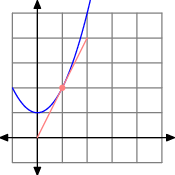1. Overview. Suppose we have a line in the plane
. What data do we need to specify a line?
We need a slope and a point
on the line
. Then we can specify
completely by the equation
(1)
We can rewrite this as
(2)
Lets remember this.
Last time we discussed the derivative, and the derivative gives us the slope at a point . But look: we have the slope from the derivative.
What more information do we need to compute a line? We need a point on the curve! So if is a curve, and
is a point on the curve, then we can compute the line tangent to
at
as
(3)
This uses the derivative as the slope, and the data
.
(We should quickly prove to ourselves this passes through the desired point. It is a one minute check that . We also see it has the desired slope, and it is in fact a line.)
Lets now consider a few examples.
2. Basic Algorithm. So, what’s the basic algorithm when finding the tangent line of the curve at the point
?
Step 1. Find the derivative .
Step 2. Using Step 1’s results, evaluate the derivative at , i.e., evaluate
.
Step 3. Using Step 2’s results, plug it into the formula .
We will do each step and draw the doodles as we go.
Example 1. Lets find the tangent line passing through the point for the curve
. What to do?
Step 0: draw the curve. We will doodle the curve in blue, just so we understand which part of the graph is the curve.

Step 1: find the derivative . We see that the derivative for
is, well, by using linearity
Then we invoke the power rule to find
Thus we find
This concludes step 1.
Step 2: Evaluate . OK, so we just found
and we have
. Thus we find
This concludes step 2.
Step 3: Construct Tangent Line. Well, we have the formula for the tangent line be
We have everything we need. We plug in and
, and results from step 2, to get
But we may simplify things out:
Thus the tangent to at
is
We can doodle this:

Note the curve is doodled in blue, the tangent point is emphasized, and the tangent line is doodled in pink.
Conclusion.
We will conclude this post with motivation for the next:
Problem. We want to find some curve
such that at any point
on the curve its tangent line
satisfies the property
. What is
?
(The field called “Differential Equations” studies this general sort of problem “Find the curve whose derivative satisfies…”)

Pingback: Exponential Function | My Math Blog
Pingback: Tangent Lines as Linear Approximations | My Math Blog
Pingback: Optimization (Motivation) | My Math Blog
Pingback: [Index] Calculus of a Single Variable | My Math Blog
Pingback: [Index] Calculus in a Single Variable | My Math Blog